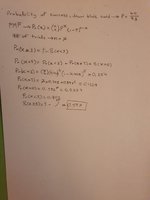FillenNaymeer
New member
- Joined
- Apr 7, 2021
- Messages
- 2
If I had a deck of cards with 40 blue cards and 58 red cards, so a total of 98 cards shuffled randomly, and i drew a hand of 7 cards, what is the probability that I draw 3 or more blue cards in the hand?
Thanks for any help you all can offer, a solution with some explanation would be greatly appreciated.
Thanks for any help you all can offer, a solution with some explanation would be greatly appreciated.

